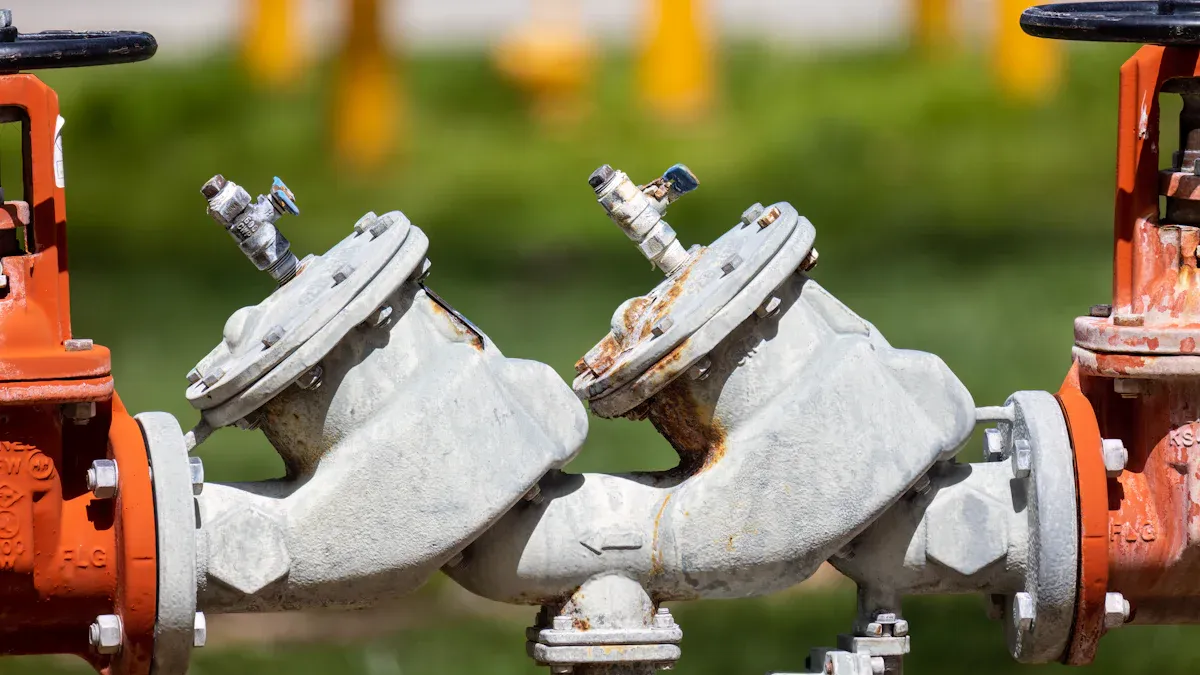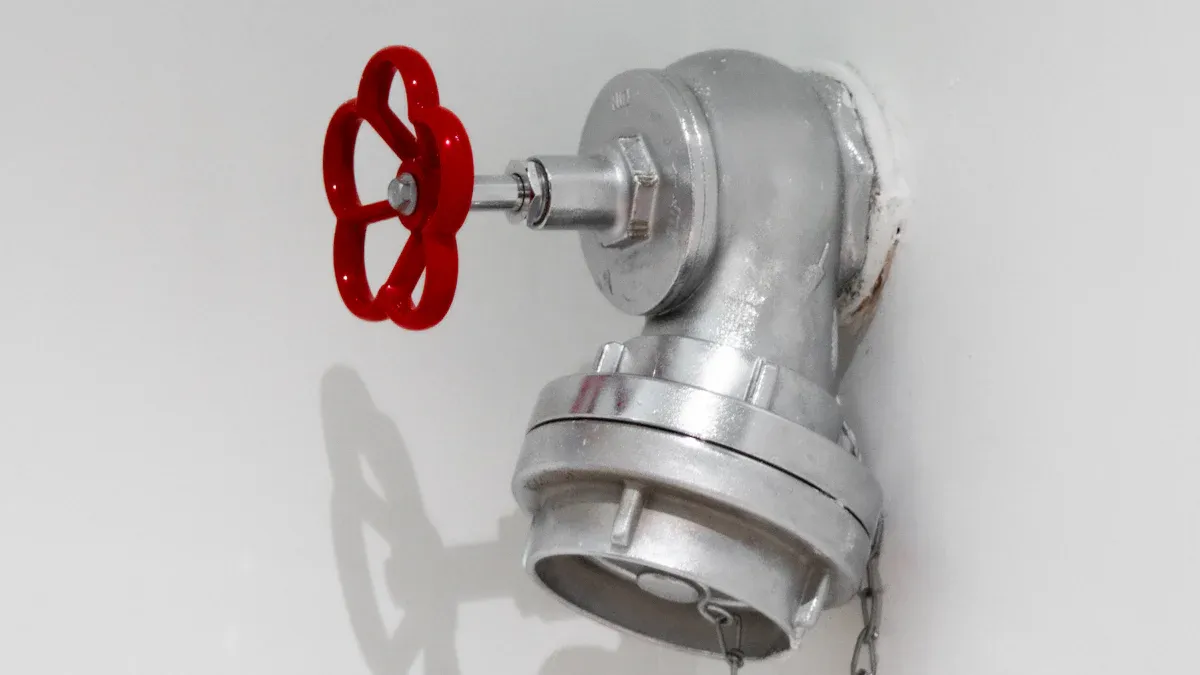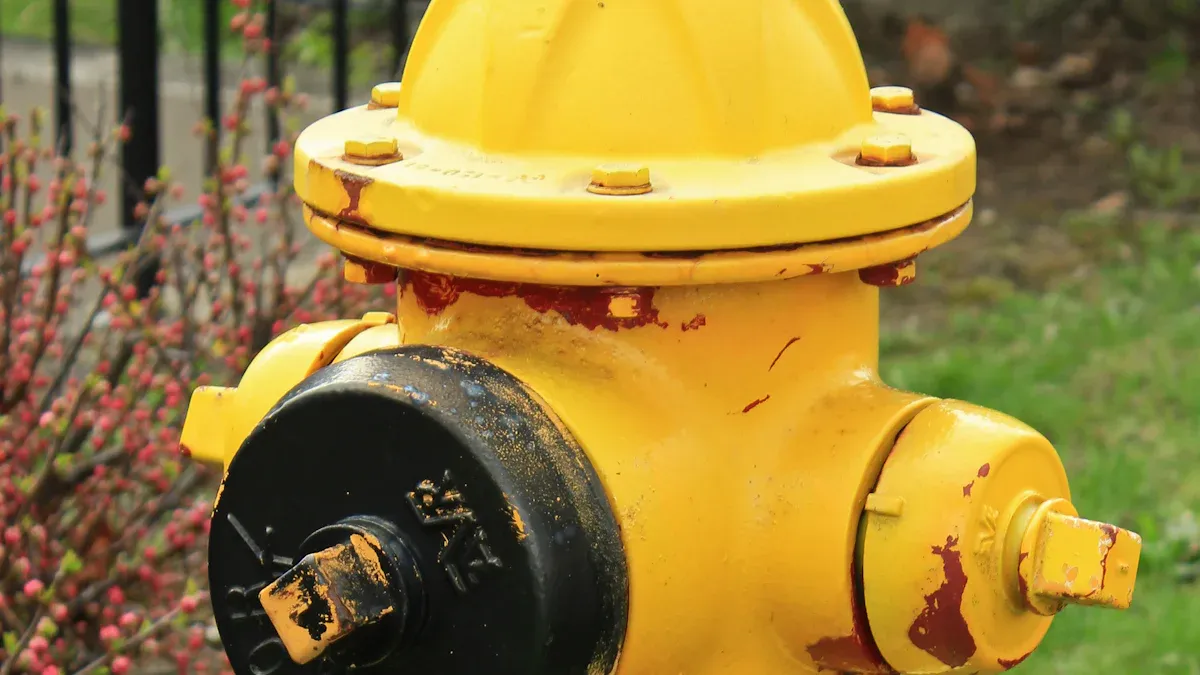
Corrosion resistance plays a vital role in hydrant valve material selection. These valves must endure exposure to water, chemicals, and environmental elements. Bronze offers exceptional durability and resists corrosion effectively, making it a trusted choice for many fire hydrant valve applications. Selecting the right material ensures long-term performance and reliability in fire hydrant systems.
Key Takeaways
- Bronze does not rust easily, so it works well for hydrant valves in tough places like near the ocean.
- Brass costs less and is simpler to shape, making it good for easier jobs where rust isn’t a big problem.
- Picking the best material depends on the weather, cost, and how well it needs to work over time.
Understanding Hydrant Valve Materials
What is Bronze?
Bronze is a metal alloy primarily composed of copper and tin, with additional elements like silicon, zinc, and phosphorus enhancing its properties. This composition makes bronze highly resistant to corrosion, especially in environments exposed to saltwater. Gunmetal, a type of tin bronze, is particularly effective in preventing salt-water corrosion and dezincification, making it ideal for marine applications such as hydrant valves. The addition of tin increases the alloy’s strength and hardness, enabling it to withstand heavy loads and harsh conditions.
What is Brass?
Brass is another copper-based alloy, but it incorporates zinc as its primary secondary element. Its typical composition includes 59-62% copper, with smaller amounts of arsenic, tin, lead, and iron. The remainder consists of zinc. Brass performs well in many applications, but its corrosion resistance depends on its zinc content. Alloys with less than 15% zinc resist dezincification better, while those with higher zinc levels may become vulnerable. DZR brass, which includes arsenic, offers improved resistance to dezincification, making it suitable for hydrant valve applications in less aggressive environments.
Key Differences Between Bronze and Brass
Bronze and brass differ significantly in composition and performance. Bronze, with its tin content, excels in resisting corrosion, particularly in saltwater environments. It also offers greater strength and durability under heavy loads. Brass, on the other hand, is more cost-effective and easier to machine, but its corrosion resistance varies based on zinc content. While bronze is preferred for hydrant valves in harsh conditions, brass may be chosen for applications where cost and machinability are priorities.
Corrosion Resistance in Hydrant Valves

How Bronze Performs in Corrosion Resistance
Bronze demonstrates exceptional corrosion resistance, making it a reliable material for hydrant valves in challenging environments. Its high copper content, combined with tin and other elements, creates a natural barrier against oxidation and chemical reactions. This property allows bronze to resist the effects of water, including saltwater, which often accelerates corrosion in other materials.
In marine or coastal areas, bronze hydrant valves maintain their structural integrity over time. The alloy’s resistance to dezincification, a process where zinc leaches out of the material, further enhances its durability. Additionally, bronze withstands exposure to various chemicals, ensuring consistent performance in industrial or municipal fire protection systems. Its ability to endure harsh conditions makes it a preferred choice for long-term applications.
How Brass Performs in Corrosion Resistance
Brass offers moderate corrosion resistance, depending on its composition. Alloys with lower zinc content, such as DZR (dezincification-resistant) brass, perform better in environments where water and moisture are present. However, brass is more susceptible to dezincification compared to bronze, especially in aggressive conditions like saltwater exposure.
Despite this limitation, brass hydrant valves can perform well in less demanding environments. For instance, they are suitable for indoor or urban applications where exposure to corrosive elements is minimal. The addition of arsenic or tin in certain brass alloys improves their resistance to corrosion, making them a viable option for specific use cases.
Environmental Factors Impacting Corrosion Resistance
Environmental conditions play a significant role in determining the corrosion resistance of hydrant valve materials. Factors such as water composition, temperature, and exposure to chemicals influence the rate of corrosion. Saltwater environments, for example, accelerate the corrosion process due to the presence of chloride ions. In such cases, bronze outperforms brass due to its superior resistance to salt-induced damage.
Industrial settings may expose hydrant valves to chemicals or pollutants that can corrode certain materials. Bronze’s ability to resist chemical reactions makes it a better choice for these environments. On the other hand, brass may suffice in controlled environments with minimal exposure to corrosive agents. Understanding the specific environmental conditions helps in selecting the most suitable material for hydrant valves, ensuring durability and reliability.
Material Performance in Hydrant Valve Applications

Bronze in Hydrant Valve Applications
Bronze demonstrates exceptional performance in hydrant valve applications, particularly in environments with high humidity or salinity. Its composition, primarily copper and tin, provides natural resistance to corrosion. This makes bronze an excellent choice for marine and coastal areas where saltwater exposure is a concern. Nickel-aluminum bronze (NAB), a specialized variant, further enhances corrosion resistance. Advanced manufacturing techniques improve its durability, ensuring reliable performance in harsh conditions.
Bronze hydrant valves also excel in industrial settings. Their ability to withstand exposure to chemicals and pollutants ensures long-term functionality. The material’s strength and hardness allow it to endure heavy loads and high-pressure systems. These qualities make bronze a preferred option for municipal fire protection systems and other demanding applications.
Brass in Hydrant Valve Applications
Brass offers versatility and cost-effectiveness in hydrant valve applications. Its zinc content, combined with other elements like aluminum and nickel, enhances its corrosion resistance. This makes brass suitable for moderate environments, such as urban or indoor settings, where exposure to corrosive elements is limited.
DZR (dezincification-resistant) brass performs well in areas with water and moisture. The addition of arsenic or tin improves its resistance to dezincification, ensuring durability in less aggressive conditions. Brass hydrant valves are also easier to machine, making them a practical choice for applications requiring custom designs or quick production. While not as robust as bronze, brass remains a viable option for specific use cases where cost and machinability are priorities.
Choosing the Best Material for Specific Environments
Selecting the right material for hydrant valves depends on environmental factors and application requirements. Humidity, salinity, and chemical exposure significantly influence corrosion rates. In marine or coastal areas, bronze outperforms brass due to its superior resistance to salt-induced damage. Nickel-aluminum bronze offers additional protection in highly corrosive environments.
For moderate environments, brass with aluminum and nickel provides adequate corrosion resistance. DZR brass is ideal for areas with water exposure but minimal salinity. Industrial settings may require bronze due to its ability to resist chemical reactions and maintain structural integrity.
Tip: Assessing environmental conditions and performance needs ensures the optimal material choice for hydrant valves. Yuyao World Fire Fighting Equipment Factory offers a range of high-quality hydrant valves designed to meet diverse application requirements.
Additional Considerations for Hydrant Valve Materials
Cost and Budget Implications
Material selection for hydrant valves often hinges on cost considerations. Bronze, known for its superior corrosion resistance and durability, typically commands a higher upfront price. However, its longevity and reduced maintenance requirements make it a cost-effective choice over time. Brass, on the other hand, offers a more affordable initial investment. Its moderate corrosion resistance suits applications with less demanding environmental conditions, making it a practical option for budget-conscious projects.
When evaluating costs, decision-makers should consider the total lifecycle expenses. Materials like bronze may reduce long-term costs by minimizing replacements and repairs. For applications requiring frequent valve replacements, brass provides a more economical solution. Balancing initial costs with long-term savings ensures optimal resource allocation.
Machinability and Fabrication Ease
Ease of machining plays a critical role in hydrant valve production. Brass, with its softer composition, is easier to machine and fabricate. This property allows manufacturers to create complex designs efficiently, reducing production time and costs. Bronze, while harder and more durable, requires advanced machining techniques. Its higher density and strength may increase fabrication complexity, but these attributes contribute to its reliability in demanding environments.
Materials like PEEK demonstrate how machinability impacts efficiency. PEEK’s lightweight nature reduces wear and tear on machinery, enhancing overall productivity. Manufacturers should assess the trade-offs between machining ease and material performance to select the best option for their needs.
Strength and Durability in Hydrant Valves
Durability remains a cornerstone of hydrant valve material selection. Bronze excels in high-pressure systems and harsh environments due to its strength and resistance to corrosion. Its ability to withstand heavy loads and extreme conditions ensures long-term reliability. Brass, while less robust, performs adequately in moderate environments. Its strength suffices for applications with lower pressure and minimal exposure to corrosive elements.
Innovative materials like PEEK highlight the importance of durability. PEEK operates efficiently at high temperatures and resists corrosion, offering a balance of resilience and longevity. For hydrant valves, selecting materials with proven durability ensures consistent performance and reduces maintenance needs.
Tip: Yuyao World Fire Fighting Equipment Factory provides hydrant valves crafted from high-quality materials, ensuring durability and reliability across diverse applications.
Bronze provides superior corrosion resistance, making it the optimal choice for hydrant valve applications in harsh environments. Brass offers a cost-effective alternative for less demanding conditions. Material selection depends on environmental exposure, budget, and performance needs. Yuyao World Fire Fighting Equipment Factory delivers high-quality hydrant valves tailored to diverse application requirements.
FAQ
What makes bronze more corrosion-resistant than brass?
Bronze contains tin, which enhances its resistance to oxidation and chemical reactions. This composition makes it ideal for environments with high salinity or chemical exposure.
Can brass hydrant valves be used in coastal areas?
Brass hydrant valves are not recommended for coastal areas. Saltwater accelerates corrosion, and bronze offers better durability in such conditions.
How does Yuyao World Fire Fighting Equipment Factory ensure material quality?
Yuyao World Fire Fighting Equipment Factory uses advanced manufacturing techniques and high-quality alloys to produce durable hydrant valves suitable for diverse environmental conditions.
Post time: May-20-2025

